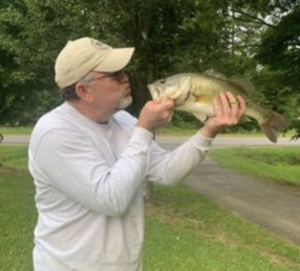
LARGEMOUTH BASS INFORMATION PAGE

Under healthy pond conditions Large Mouth Bass spawn in high numbers and the fingerlings have good survival rates. They usually start to spawn between 1 and 2 years of age, and when the water temperature reaches 60-70 degrees.
As a general rule in a healthy pond, Bass reach 7 inches by one year of age, up to 11 inches at two years, 14 inches at three years, 16 inches at four years of age, and over 17 inches at five years. There can be up to a 4″ size difference in Bass the same age just due to the individual Bass growth rate. Adult size is considered 12″ to 30″ in length.
It is best to release large Bass and keep smaller ones if your pond isn’t overstocked with them.
Bluegill (Coppernose or Native) are the diet of choice for Bass. You should plan to restock your Bluegill fingerlings each year if your pond wasn’t stocked at optimum levels of Bass, Bluegill and Minnows to begin with. If you are stocking a pond or lake for the first time, it is recommended that you add Bluegill, Minnows and Bass in a 10 to 1 ratio per acre – based on the number of acres in your pond.
Here are the numbers to stock per acre for a full first time stocking:
1000 Bluegill with 1000-2000 Minnows per acre. Then 2-4 months later stock with 100 Bass and another 500 to 2000 Fathead Minnows. Add Shellcracker and/or Hybrid Crappie at 50 to 100 to the acre. Catfish are not recommended in a Bass Pond.
If you do want Catfish, stock at 50 to 100 per acre after you have stocked your Bass. Choose the Catfish number based on what you will fish out in about 2 years time. Catfish over 2 lbs can compete with Bass for food, and cause them to start stunting. Bass do not recover and reach full size once they have stunted.
If you practice catch and release with large Bass, take care in removing the hook. Tearing it out can cause bacterial infection to set in. It can also tear the jaw or damage the maxillary. Back the hook out after catching the fish, don’t rip it out. Removing your hook carefully and right after the catch is best for the fish. Having a fellow fisherman control the fish as you remove the hook can make a big difference in the successful removal and can reduce the time it takes to get the fish back in the water.
If the Bass in your pond are skinny there can be a number of reasons why. One possibility is that you have to many Catfish that have grown to large. If you don’t harvest your Catfish by the time they are about 2 lbs in size they become eating machines. Catfish keep growing because they can eat a huge variety of things – small Bluegill fingerlings, minnows, algae, weeds, grubs, mussels, snails, even small ducklings. Bass are not able to eat these additional food sources, so if the Catfish have cleared out the Bluegill and Minnows, the Bass begin to starve.
The second reason may be that you have to many large Bass in the pond, and they are clearing out the food chain. In addition to Bluegill fingerlings, you can add some adult Bluegill to help re-populate naturally (500 to 1,500 per acre) , and you can also add the quantity of Minnows recommended per acre each year (1,000 to 2,000 per acre). Remember that Bluegill fingerlings are the food of choice for Bass, and Fathead Minnows are a favorite of Bass, Bluegill and Catfish.
A third reason may be that a Bass spawn/hatch out was to good, and to many Bass survived and are now competing. If so, they can clear the pond of food. In that case you need to heavily fish your pond to reduce their numbers.
When possible, restock Bluegill fingerlings and Minnows each year based on your pond acreage, and fish your pond appropriately.
Where food production and fishing are the main goals, the Northern Large Mouth Bass should be stocked because they are easier to catch. For challenge and sport fishing, stock Florida or the F1 Hybrid Bass. If you mix Florida and Northern Large Mouth Bass in a pond, you will get the desirable F1 Hybrid Bass as a result. The F1 Hybrid is the first generation spawn from a mix of Florida and Northern Large Mouth Bass.
See our Article Page on producing a Trophy Bass pond if that interests you.
